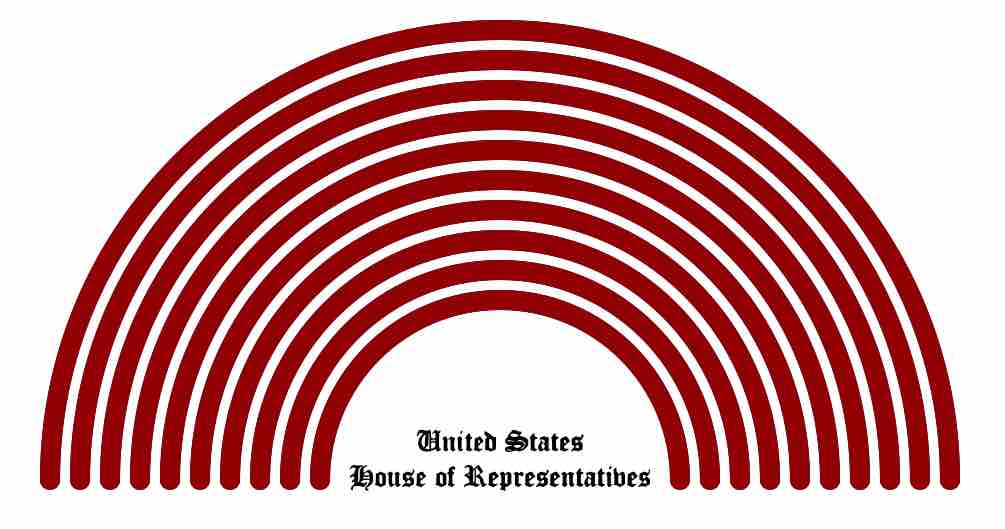Two-party system
A two-party system is a system in which two major political parties dominate voting in nearly all elections at every level of government and the majority of elected offices are members of one of the two major parties. Under a two-party system, one party typically holds a majority in the legislature and is usually referred to as the majority party while the other is the minority party. The United States is an example of a two-party system in which the majority of elected officials are either Democrats or Republicans .

The United States Two-Party System
Breakdown of political party representation in the United States House of Representatives during the 112th Congress. Blue: Democrat Red: Republican.
The modern political party system in the U.S. is a two-party system dominated by the Democratic Party and the Republican Party. These two parties have won every United States presidential election since 1852 and have controlled the United States Congress to some extent since at least 1856. However, the political party system did not develop until tax reform. The First Party System of the United States featured the Federalist Party and the Democratic-Republican Party (Anti-Federalist). In 1829, the Second Party System saw a split of the Democratic-Republican Party into the Jacksonian Democrats, who grew into the modern Democratic Party, led by Andrew Jackson, and the Whig Party, led by Henry Clay. The Third Party System stretched from 1854 to the mid-1890s, and was characterized by the emergence of the anti-slavery Republican Party, which adopted many of the economic policies of the Whigs, such as national banks, railroads, high tariffs, homesteads and aid to land grant colleges. The Fourth Party System, 1896 to 1932, retained the same primary parties as the Third Party System, but saw major shifts in the central issues of debate. This period also corresponded to the Progressive Era, and was dominated by the Republican Party. The Fifth Party System emerged with the New Deal Coalition beginning in 1933. The Republicans began losing support after the Great Depression, giving rise to Democratic President Franklin D. Roosevelt and the activist New Deal. Experts debate whether this era ended in the mid-1960s when the New Deal coalition did, the early 1980s when the Moral Majority and the Reagan coalition were formed, the mid-1990s during the Republican Revolution, or continues to the present. Since the 1930s, the Democrats positioned themselves more towards Liberalism while the Conservatives increasingly dominated the GOP.
Causes
There are several reason two major parties often dominate the political landscape in some systems. In the U.S., forty-eight states have a standard winner-takes-all electoral system for amassing presidential votes in the Electoral College system. The winner–takes–all principle applies in presidential elections, thus if a presidential candidate gets the most votes in any particular state, all of the electoral votes from that state are awarded to the candidate. In all but Maine and Nebraska, the presidential candidate must win a plurality of votes to wins all of the electoral votes; this practice is called the unit rule.
There are two main reasons winner–takes–all systems lead to a two-party system. First, the weaker parties are pressured to form an alliance, sometimes called a fusion, attempting to become big enough to challenge a large dominant party and, in so doing, gain political clout in the legislature. Second, voters learn, over time, not to vote for candidates outside of one of the two large parties since their votes for third party candidates are usually ineffectual. Therefore, weaker parties are eliminated by the voters over time. The gravitation of voters towards one of the two main parties is called polarization.
Advantages and Disadvantages
One opinion in political science is that a two-party system promotes centrism, less extremism, and that a two-party system is generally more stable and easier to govern than multi-party systems which can become a hung parliament. However, two-party systems have been criticized for ignoring alternative views and putting a damper on debate within a nation. Multi-party governments tend to permit wider and more diverse viewpoints in government and encourage dominant parties to make deals with weaker parties to form winning coalitions. Compared to the United States' two-party system, the most common form of democracy is the British multi-party model.
There have been arguments that the winner-take-all mechanism discourages independent or third-party candidates from running for office or promulgating their views. One analyst suggested that parliamentary systems, which typically are multi-party in nature, lead to a better "centralization of policy expertise" in government. Multi-party governments permit wider and more diverse viewpoints in government, and encourage dominant parties to make deals with weaker parties to form winning coalitions. While there is considerable debate about the relative merits of a constitutional arrangement such as that of the United States versus a parliamentary arrangement such as Britain, analysts have noted that most democracies around the world have chosen the British multi-party model.